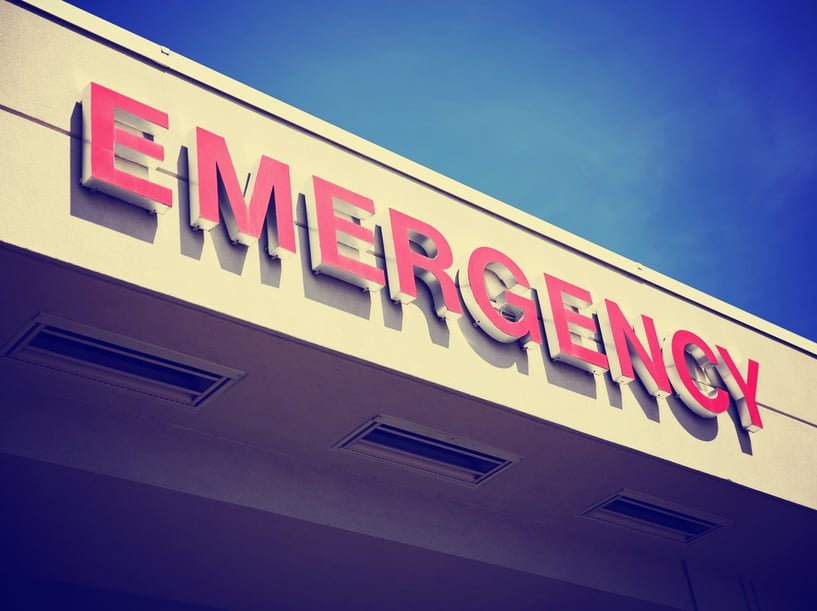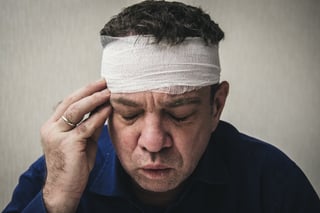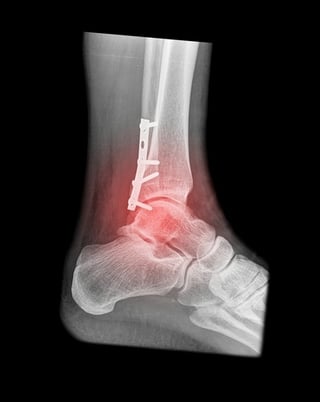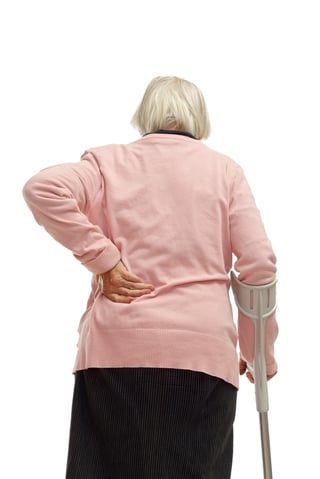Risks of not treating an injury immediately | Corpus Christi, Texas
July 25th, 2016 | 5 min. read


People injure themselves every day, but not everyone seeks treatment immediately like they should. If you have a musculoskeletal injury like a concussion, bone break, sprain, or ligament or tendon damage, not seeking treatment could have serious consequences for your health.
Athletes, especially those who compete (like high school athletes), often "push through" the pain of an injury because they want to keep playing. In some cases, they're so accustomed to discomfort that they may not even notice they've sustained an injury.
Non-athletes also sometimes ignore the symptoms of an injury, for their own reasons.
- Elderly individuals may ignore their injuries to avoid burdening anyone. In some cases, seniors will even hide their symptoms in order to avoid a loss of independence or a hospital or nursing home stay.
- Employees may hide their symptoms in order to avoid a loss of income from a leave of absence or a period of unemployment.
Overlooking or hiding an injury can be dangerous. In the long run, the cost of an untreated injury can be much higher than getting treatment immediately.
Down the line, untreated concussions, fractures, and soft tissue damage can cause you a great deal of pain, inconvenience, time, and money as the problem compounds and leads to other health issues that may be more difficult (and time-consuming) to treat.
What follows are some common categories of injuries that, left untreated, can cause serious problems for your health.
Concussions

All blows to the head or instances of severe and forceful shaking (for example, during a fender bender) should be taken seriously, especially if you experience any concussion symptoms after the incident.
Concussion symptoms can include some or all of the following: a loss of consciousness/blackout, headache, nausea, vomiting, confusion, clumsiness, dizziness, loss of equilibrium or balance, memory loss, sensitivity to light or noise, a ringing in the ears, or sleepiness or fatigue.
A concussion is classified as a mild traumatic brain injury (MTBI). See a doctor if you suspect you've been concussed.
Risks of not treating concussions:
Left untreated, concussions can lead to post-concussive syndrome and a number of varied symptoms and health issues, including (but not limited to):
- Eye pain and blurry vision
- Memory loss, brain fog, and attention issues
- Headaches
- Fatigue
- Sleep disturbance
- Balance issues (vertigo, dizziness), which can lead to falls
- Emotional problems (crying, sudden flare-ups of anger)
- Brain swelling, which could cause a stroke
- Epilepsy
- Depression, anxiety, or phobias, caused by changes in the brain due to inflammation
Though some of these outcomes are rare, they are a possibility.
If you or someone you know has suffered a blow to the head (especially older people taking blood thinners), the safest course is to see a doctor right away.
Rest and observation will be prescribed, and in some cases medication may also be advised.
Fractures

In some cases, people may sustain fractures without realizing the severity of their injuries (see below, osteoporosis).
How do you know if you have a fracture?
If you have pain, swelling, or bruising over an area of your body after an injury, or if a body part is deformed or angulated, you may have a fracture.
Other symptoms include a grinding sensation and difficulty putting weight or pressure on the body part in question (for example, standing on a broken foot).
While some fractures are more serious than others, any fracture should be evaluated as soon as possible so it can be diagnosed, immobilized, and in some cases repaired or managed with a cast or surgery. Fracture can most often be diagnosed with a simple x-ray.
Risks of not treating fractures:
- Pain. Untreated fractures may cause ongoing and sometimes excruciating pain. Re-fractures are also possible.
- Deformity. Unset bones can heal incorrectly, leading to protuberances and misalignments that can be unsightly as well as harmful to function and mobility.
- Joint damage and arthritis. If fractured bones heal out of alignment, the biomechanics of the injured area are altered, which can lead to friction and inflammation. Degeneration of joint cartilage and bone can result.
- Muscle, ligament, or nerve damage. Broken bone can tear or injure adjacent soft tissues.
- Blood clots. Deep vein thrombosis can be an early complication after sustaining a bone break. Without treatment, dangerous, potentially limb- or life-threatening clots can go undetected.
- Tissue or bone death. If you've sustained a crush injury (for example, in a car accident), the blood vessels supplying blood to your extremities could be blocked, which can prevent wounds from healing. Necrosis of the bone may also take place.
Many other health side effects can occur if you don't seek care for your fracture right away. The safest course of action is to see a doctor as soon as possible.
Osteoporosis

Due to reduced bone density, people with osteoporosis have brittle bones and are more susceptible to breaks and cracks. These patients can sometimes sustain fractures from very low energy injuries.
These fractures may not heal well because bone tissue doesn't regenerate as well as it did when patients were younger.
Symptoms:
If you have osteoporosis, you may feel pain, tenderness, bruising, or a loss of function in the affected body part.
For example, a vertebra fracture in your back may mean you have trouble bending forward or to the side.
Wrist fractures and hip fractures are also common in people with osteoporosis.
Risks of not treating osteoporosis injuries:
-
Pain. Untreated fractures can lead to chronic pain, which can affect your ability to function.
-
Loss of mobility. Untreated fractures in the back, legs, hips, and feet can make walking difficult. Upper body fractures may restrict your ability to do everyday activities like bathing or shopping.
-
Expense. Loss of independence can lead to the need for at-home care, nursing home care, or hospitalization.
-
Depression. Being in pain and unable to get around can often lead to anxiety and social isolation.
-
Other health problems. Weight gain or obesity can result from loss of mobility and pain. This, in turn, can lead to other health conditions like diabetes, heart disease, and arthritis.
Seeing a doctor early can help you to get medications, therapies, and advice on how to best to treat an injury.
Soft tissue injuries: ligaments, tendons, and muscles
Strains, sprains, tendonitis, tears, and ruptures are common injuries in people of all ages and of all activity levels. At some point or another, most of us will experience one or more of these injuries as we go through life.
Some soft tissue injuries are less serious than others. Tendonitis, for example, tends to be moderately painful and often responds to RICE therapy, physical therapy, and over-the-counter pain medication. The same can be said for some sprains and muscle strains.
Many acute injuries, however — like rotator cuff tears (shoulder), ACL tears (knee), or Achilles tendon ruptures (ankle/heel) — can be excruciating and debilitating. Without treatment, you may not be able to function properly. These types of injuries often have a window for surgical intervention for the best possible outcome. Waiting for evaluation and management can decrease your chances of a good outcome, because torn soft tissues will retract and atrophy over time, making them difficult or impossible to repair.

Risks of not treating ligament, tendon, and muscle injuries:
- Pain. By not treating your injuries when they first occur, you might be making them worse. Small meniscus tears in the knee, for example, can become larger tears.
- Instability. Untreated injuries can lead to the affected body part being unstable when performing certain actions. An untreated knee injury, for example, may click, catch, or buckle repeatedly, sometimes with pain. Injuries can also heal and become re-injured later.
- Disability. Left untreated, injuries like partial tendon tears can become full ruptures that leave no connection between bones and muscle. Achilles tendon ruptures and ACL ruptures can disable your ability to put weight on your legs, bend or straighten your knees, stand on tiptoe, or walk with a normal heel-to-toe stride.
- Arthritis. Untreated soft tissue injuries can change the way you move your joints, forcing other tissue and bones to "take up the slack" to compensate for weakness. The altered biomechanics can lead to wear and tear on the cartilage that may turn into tissue degeneration and ultimately osteoarthritis (OA).
The first step to getting better is a diagnosis. If you live near Corpus Christi, call Coastal Orthopedics at 361.994.1166 to make an appointment for an examination.
Article written by: Rob Williams, MD
Dr. Williams has been practicing orthopedic surgery in Corpus Christi since 1998. After graduating from Texas Tech hereceived his medical degree from the University of Texas at San Antonio. At the prestigious Campbell Clinic located at the University of Tennessee, Dr. Williams completed not only an Orthopedic Surgery Residency, but an additional year of Fellowship Training in Spine Surgery. Dr. Williams is dedicated to creating an excellent patient experience in the office or in the surgery suite.
Topics:

